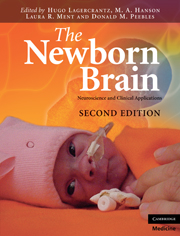Book contents
- Frontmatter
- Contents
- List of contributors
- Preface to the First Edition
- Preface to the Second Edition
- 1 Reflections on the origins of the human brain
- Section 1 Making of the brain
- 2 The molecular basis of central nervous system development
- 3 Holoprosencephaly and microcephaly vera: perturbations of proliferation
- 4 Neuronal migration
- 5 The neonatal synaptic big bang
- 6 Neurotrophic factors in brain development
- 7 Neurotransmitters and neuromodulators
- 8 Glial cell biology
- Section 2 Sensory systems and behavior
- Section 3 Radiological and neurophysiological investigations
- Section 4 Clinical aspects
- Section 5 Follow-up
- Section 6 Consciousness
- Index
- Plate section
- References
6 - Neurotrophic factors in brain development
from Section 1 - Making of the brain
Published online by Cambridge University Press: 01 March 2011
- Frontmatter
- Contents
- List of contributors
- Preface to the First Edition
- Preface to the Second Edition
- 1 Reflections on the origins of the human brain
- Section 1 Making of the brain
- 2 The molecular basis of central nervous system development
- 3 Holoprosencephaly and microcephaly vera: perturbations of proliferation
- 4 Neuronal migration
- 5 The neonatal synaptic big bang
- 6 Neurotrophic factors in brain development
- 7 Neurotransmitters and neuromodulators
- 8 Glial cell biology
- Section 2 Sensory systems and behavior
- Section 3 Radiological and neurophysiological investigations
- Section 4 Clinical aspects
- Section 5 Follow-up
- Section 6 Consciousness
- Index
- Plate section
- References
Summary
Neurotrophic factors are target-derived survival factors
During nervous system development, neurons are generated in numbers exceeding those found in adults. The surplus neurons are eliminated by programmed cell death. In higher organisms this process is influenced by factors outside the cells themselves, called neurotrophic factors. The discovery of neurotrophic factors goes back to the 1950s, when Rita Levi-Montalcini was investigating the relationship between the nervous system and its peripheral targets. She and her collaborators found that on removal of an organ from a chick embryo, its innervating ganglion neurons were lost as well. Conversely, the addition of an extra target resulted in excessive neuronal survival. She postulated that a soluble factor produced by the target promoted neuronal survival. Eventually this factor was isolated and named nerve growth factor (NGF; Cohen & Levi-Montalcini, 1957). A related protein was purified from pig brain in 1982, and was named brain-derived neurotrophic factor (BDNF; Barde et al., 1982). With the discovery of BDNF, a family of neurotrophic factors was established: the NGF family of neurotrophic factors, or the neurotrophins. Since then the mammalian branch of the family has been gifted with two additional members, neurotrophin-3 (NT-3) (Hohn et al., 1990) and NT-4 (Hallbook et al., 1991). To date several proteins with neurotrophic action have been described. Apart from the neurotrophins, members of the glial cell line-derived (GDNF) factor family are the most important.
Neurotrophic factors and their receptors are expressed during development and in adulthood.
- Type
- Chapter
- Information
- The Newborn BrainNeuroscience and Clinical Applications, pp. 85 - 98Publisher: Cambridge University PressPrint publication year: 2010



